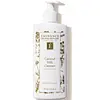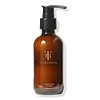What's inside
What's inside
 Key Ingredients
Key Ingredients

 Benefits
Benefits

 Concerns
Concerns

 Ingredients Side-by-side
Ingredients Side-by-side

Terminalia Ferdinandiana Fruit Extract
AntioxidantMalt Juice
Skin ConditioningCitrus Limon Juice
Skin ConditioningPyrus Malus Juice
Skin ConditioningCalendula Officinalis Flower Extract
MaskingHydrolyzed Carrot Extract
Skin ConditioningTrifolium Pratense Extract
Skin ConditioningMilk
Skin ConditioningVitis Vinifera Seed Extract
AntimicrobialDioscorea Villosa Root Extract
Skin ConditioningRosmarinus Officinalis Leaf Extract
AntimicrobialCyamopsis Tetragonoloba Gum
Emulsion StabilisingZea Mays Silk Extract
Skin ConditioningGlycine Soja Extract
Skin ConditioningCitric Acid
BufferingMaltodextrin
AbsorbentZea Mays Oil
EmulsifyingHelianthus Annuus Seed Oil
EmollientGlycerin
HumectantStearic Acid
CleansingGlyceryl Stearate
EmollientCetearyl Alcohol
EmollientSodium Cetearyl Sulfate
CleansingCaesalpinia Spinosa Gum
Skin ConditioningCocos Nucifera Oil
MaskingCocos Nucifera Fruit Extract
EmollientRicinus Communis Seed Oil
MaskingBenzyl Alcohol
PerfumingDehydroacetic Acid
PreservativeSalicylic Acid
MaskingMethyl Glucose Sesquistearate
EmollientXanthan Gum
EmulsifyingSodium Benzoate
MaskingPotassium Sorbate
PreservativeCalendula Officinalis Flower Oil
MaskingLactic Acid
BufferingCalcium Ascorbate
AntioxidantTocopherol
AntioxidantLecithin
EmollientCitrus Limon Fruit Extract
MaskingMalpighia Emarginata Fruit Extract
Skin ConditioningPhyllanthus Emblica Fruit Extract
HumectantAdansonia Digitata Seed Oil
EmollientCamphor
MaskingDaucus Carota Sativa Root Extract
Skin ConditioningCocos Nucifera Water
MaskingLycium Barbarum Fruit Extract
AstringentTapioca Starch
Thioctic Acid
AntioxidantTerminalia Ferdinandiana Fruit Extract, Malt Juice, Citrus Limon Juice, Pyrus Malus Juice, Calendula Officinalis Flower Extract, Hydrolyzed Carrot Extract, Trifolium Pratense Extract, Milk, Vitis Vinifera Seed Extract, Dioscorea Villosa Root Extract, Rosmarinus Officinalis Leaf Extract, Cyamopsis Tetragonoloba Gum, Zea Mays Silk Extract, Glycine Soja Extract, Citric Acid, Maltodextrin, Zea Mays Oil, Helianthus Annuus Seed Oil, Glycerin, Stearic Acid, Glyceryl Stearate, Cetearyl Alcohol, Sodium Cetearyl Sulfate, Caesalpinia Spinosa Gum, Cocos Nucifera Oil, Cocos Nucifera Fruit Extract, Ricinus Communis Seed Oil, Benzyl Alcohol, Dehydroacetic Acid, Salicylic Acid, Methyl Glucose Sesquistearate, Xanthan Gum, Sodium Benzoate, Potassium Sorbate, Calendula Officinalis Flower Oil, Lactic Acid, Calcium Ascorbate, Tocopherol, Lecithin, Citrus Limon Fruit Extract, Malpighia Emarginata Fruit Extract, Phyllanthus Emblica Fruit Extract, Adansonia Digitata Seed Oil, Camphor, Daucus Carota Sativa Root Extract, Cocos Nucifera Water, Lycium Barbarum Fruit Extract, Tapioca Starch, Thioctic Acid
Camellia Sinensis Leaf Extract
AntimicrobialGlycerin
HumectantCamellia Oleifera Seed Oil
Skin ConditioningWater
Skin ConditioningAloe Barbadensis Leaf Juice
Skin ConditioningLauryl Lactyl Lactate
Skin ConditioningCaprylyl/Capryl Glucoside
CleansingCocamidopropyl Hydroxysultaine
CleansingXanthan Gum
EmulsifyingCitrus Grandis Peel Oil
MaskingJasminum Sambac Flower Oil
MaskingLavandula Hybrida Oil
EmollientVetiveria Zizanoides Root Oil
MaskingSodium Chloride
MaskingEthylhexylglycerin
Skin ConditioningCitric Acid
BufferingLimonene
PerfumingLinalool
PerfumingPhenethyl Alcohol
MaskingCamellia Sinensis Leaf Extract, Glycerin, Camellia Oleifera Seed Oil, Water, Aloe Barbadensis Leaf Juice, Lauryl Lactyl Lactate, Caprylyl/Capryl Glucoside, Cocamidopropyl Hydroxysultaine, Xanthan Gum, Citrus Grandis Peel Oil, Jasminum Sambac Flower Oil, Lavandula Hybrida Oil, Vetiveria Zizanoides Root Oil, Sodium Chloride, Ethylhexylglycerin, Citric Acid, Limonene, Linalool, Phenethyl Alcohol
Ingredients Explained
These ingredients are found in both products.
Ingredients higher up in an ingredient list are typically present in a larger amount.
Citric Acid is an alpha hydroxy acid (AHA) naturally found in citrus fruits like oranges, lemons, and limes.
Like other AHAs, citric acid can exfoliate skin by breaking down the bonds that hold dead skin cells together. This helps reveal smoother and brighter skin underneath.
However, this exfoliating effect only happens at high concentrations (20%) which can be hard to find in cosmetic products.
Due to this, citric acid is usually included in small amounts as a pH adjuster. This helps keep products slightly more acidic and compatible with skin's natural pH.
In skincare formulas, citric acid can:
While it can provide some skin benefits, research shows lactic acid and glycolic acid are generally more effective and less irritating exfoliants.
Most citric acid used in skincare today is made by fermenting sugars (usually from molasses). This synthetic version is identical to the natural citrus form but easier to stabilize and use in formulations.
Read more about some other popular AHA's here:
Learn more about Citric AcidGlycerin is already naturally found in your skin. It helps moisturize and protect your skin.
A study from 2016 found glycerin to be more effective as a humectant than AHAs and hyaluronic acid.
As a humectant, it helps the skin stay hydrated by pulling moisture to your skin. The low molecular weight of glycerin allows it to pull moisture into the deeper layers of your skin.
Hydrated skin improves your skin barrier; Your skin barrier helps protect against irritants and bacteria.
Glycerin has also been found to have antimicrobial and antiviral properties. Due to these properties, glycerin is often used in wound and burn treatments.
In cosmetics, glycerin is usually derived from plants such as soybean or palm. However, it can also be sourced from animals, such as tallow or animal fat.
This ingredient is organic, colorless, odorless, and non-toxic.
Glycerin is the name for this ingredient in American English. British English uses Glycerol/Glycerine.
Learn more about GlycerinXanthan gum is used as a stabilizer and thickener within cosmetic products. It helps give products a sticky, thick feeling - preventing them from being too runny.
On the technical side of things, xanthan gum is a polysaccharide - a combination consisting of multiple sugar molecules bonded together.
Xanthan gum is a pretty common and great ingredient. It is a natural, non-toxic, non-irritating ingredient that is also commonly used in food products.
Learn more about Xanthan Gum